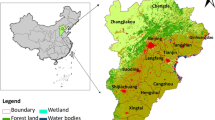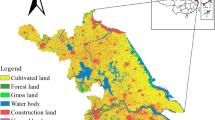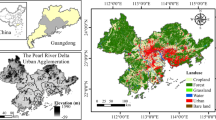Abstract
Context
When setting the goal of landscape sustainability in landscape management, a key theoretical question should be which landscape patterns are more sustainable, whereas there were few studies that further compared optimization scenarios.
Objectives
This article sought to identify the future scenario of landscape services and the most sustainable landscape in the Qinghai-Tibet Plateau.
Methods
This study adopts the parameter of ecological security pattern (ESP) combining with landscape connectivity and landscape service as indicators to assess the sustainability of landscape patterns in 2010, 2020 and 2030 with different land use scenarios in Representative Concentration Pathways.
Results
The results showed that (1) the area with high quality of the three landscape services was mainly concentrated in the southeast of the Qinghai-Tibet Plateau, where a large area of forest was distributed, and the low quality area was located in the northwest, which was bare land in 2010; (2) the landscape services showed a declining trend under the RCP 2.6 and RCP 4.5 scenarios from 2020 to 2030, whereas the values remained stable under the RCP 6.0 and RCP 8.5 scenarios; and (3) there were 9 ecological sources and 16–17 corridors within the ESP scenarios with quantitative parameters to indicate the landscape sustainability of the scenarios.
Conclusions
The approach of this study showed the possibility of using ESP scenarios to quantitatively indicate the sustainability of landscape patterns and provide guidance for future landscape management.






Similar content being viewed by others
References
Abou-Dahab TAM, Ewis STA, El-Kady AFY (2019) Towards sustainable landscape: Feasibility of using different cheese whey types in the fertigation of Schinus molle L. seedlings. J Clean Prod 235:1051–1060
Antrop M, Brandt J, Loupa-Ramos I, Padoa-Schioppa E, Porter J, Van Eetvelde V, Pinto-Correia T (2013) How landscape ecology can promote the development of sustainable landscapes in Europe: the role of the European Association for Landscape Ecology (IALE-Europe) in the twenty-first century. Landsc Ecol 28(9):1641–1647
Bastian O, Grunewald K, Syrbe R-U, Walz U, Wende W (2014) Landscape services: the concept and its practical relevance. Landsc Ecol 29(9):1463–1479
Beier P, Majka DR, Spencer WD (2008) Forks in the road: Choices in procedures for designing Wildland linkages. Conserv Biol 22(4):836–851
Bettencourt LMA, Kaur J (2011) Evolution and structure of sustainability science. P Natl Sci 108(49):19540–19545
Bohnet IC, Roebeling PC, Williams KJ, Holzworth D, van Grieken ME, Pert PL, Kroon FJ, Westcott DA, Brodie J (2011) Landscapes Toolkit: an integrated modelling framework to assist stakeholders in exploring options for sustainable landscape development. Landsc Ecol 26(8):1179
Charles M, Ziv G, Bohrer G, Bakshi BR (2020) Connecting air quality regulating ecosystem services with beneficiaries through quantitative serviceshed analysis. Ecosyst Serv 41:101057
Chen X, Shi XL (2018) Geoscience landscape division and tourism zonation in the mid-southern section of the Hengduan Mountains, eastern Qinghai-Tibet Plateau. J Mt Sci 15(4):894–917
De Montis A, Caschili S, Mulas M, Modica G, Ganciu A, Bardi A, Ledda A, Dessena L, Laudari L, Fichera CR (2016) Urban–rural ecological networks for landscape planning. Land Use Policy 50:312–327
Dickson BG, Albano CM, Anantharaman R, Beier P, Fargione J, Graves TA, Gray ME, Hall KR, Lawler JJ, Leonard PB, Littlefield CE, McClure ML, Novembre J, Schloss CA, Schumaker NH, Shah VB, Theobald DM (2019) Circuit-theory applications to connectivity science and conservation. Conserv Biol 33(2):239–249
Djalante R (2019) Key assessments from the IPCC special report on global warming of 1.5 °C and the implications for the Sendai framework for disaster risk reduction. P Disa Sci 1:100001
Dong R, Zhang X, Li H (2019) Constructing the ecological security pattern for Sponge City: A Case study in Zhengzhou. China Water 11(2):284
Doyle PG (1984) Random walk on the speiser graph of a riemann surface. B Am Math Soc 11:371–377
Fan J, Wang Y, Wang C, Chen T, Jin F, Zhang W, Li L, Xu Y, Dai E, Tao A, Zhou K, Li J, Tang Q, Chen D, Guo R (2019) Reshaping the sustainable geographical pattern: a major function zoning model and its applications in China. Earth's Future 7(1):25–42
Fraedrich K, Bordi I, Zhu X (2016) Climate dynamics on global scale: resilience, hysteresis and attribution of change. The Fluid Dynamics of Climate 564:143–159
Gurrutxaga M, Rubio L, Saura S (2011) Key connectors in protected forest area networks and the impact of highways: a transnational case study from the Cantabrian Range to the Western Alps (SW Europe). Landsc Urban Plan 101(4):310–320
Hao R, Yu D, Liu Y, Liu Y, Qiao J, Wang X, Du J (2017a) Impacts of changes in climate and landscape pattern on ecosystem services. Sci Total Environ 579:718–728
Hao R, Yu D, Wu J (2017b) Relationship between paired ecosystem services in the grassland and agro-pastoral transitional zone of China using the constraint line method. Agr Ecosyst Environ 240:171–181
Hou L, Wu F, Xie X (2020) The spatial characteristics and relationships between landscape pattern and ecosystem service value along an urban-rural gradient in Xi’an city. China Ecol Indic 108:105720
Huang L, Xiang W, Wu J, Traxler C, Huang J (2019) Integrating GeoDesign with landscape sustainability science. Sustainability 11(3):833
Jiang C, Wang F, Zhang H, Dong X (2016) Quantifying changes in multiple ecosystem services during 2000–2012 on the Loess Plateau, China, as a result of climate variability and ecological restoration. Ecol Eng 97:258–271
Kim J, Choi J, Choi C, Park S (2013) Impacts of changes in climate and land use/land cover under IPCC RCP scenarios on streamflow in the Hoeya River Basin, Korea. Sci Total Environ 452–453:181–195
Lei K, Pan H, Lin C (2016) A landscape approach towards ecological restoration and sustainable development of mining areas. Ecol Eng 90:320–325
Li B, Chen N, Wang Y, Wang W (2018) Spatio-temporal quantification of the trade-offs and synergies among ecosystem services based on grid-cells: a case study of Guanzhong Basin, NW China. Ecol Indic 94:246–253
Li S, Xiao W, Zhao Y, Lv X (2019) Incorporating ecological risk index in the multi-process MCRE model to optimize the ecological security pattern in a semi-arid area with intensive coal mining: a case study in northern China. J Clean Prod 247:119143
Li S, Zhang H, Zhou X, Yu H, Li W (2020) Enhancing protected areas for biodiversity and ecosystem services in the Qinghai-Tibet Plateau. Ecosyst Serv 43:101090
Li X, Yu L, Sohl T, Clinton N, Li W, Zhu Z, Liu X, Gong P (2016) A cellular automata downscaling based 1km global land use datasets (2010–2100). Sci Bull 61(21):1651–1661
Li Y, Cao Z, Long H, Liu Y, Li W (2017) Dynamic analysis of ecological environment combined with land cover and NDVI changes and implications for sustainable urban–rural development: the case of Mu Us Sandy Land, China. J Clean Prod 142:697–715
Li ZW, Wang ZY, Brierley G, Nicoll T, Pan BZ, Li YF (2015) Shrinkage of the Ruoergai Swamp and changes to landscape connectivity, Qinghai-Tibet Plateau. CATENA 126:155–163
Liu D, Chang Q (2015) Ecological security research progress in China. Acta Ecol Sinica 35(5):111–121
Liu J, Milne RI, Cadotte MW, Wu ZY, Provan J, Zhu GF, Gao LM, Li DZ (2018) Protect Third Pole’s fragile ecosystem. Science 362(6421):1368–1369
Liu Z, He C, Yang Y, Fang Z (2019) Planning sustainable urban landscape under the stress of climate change in the drylands of northern China: a scenario analysis based on LUSD-urban model. J Clean Prod 244:118709
McGarigal K, Marks BJ (1995) FRAGSTATS: spatial pattern analysis program for quantifying landscape structure. US Department of Agriculture Forest Service, Pacific Northwest Research Station, Washington
McRae BH, Dickson BG, Keitt TH, Shah VB (2008) Using circuit theory to model connectivity in ecology, evolution, and conservation. Ecology 89(10):2712–2724
McRae B, Shah V, Edelman A (2016) Circuitscape: modeling landscape connectivity to promote conservation and human health. Nat Conserv. https://doi.org/10.13140/RG.2.1.4265.1126
Musacchio LR (2013) Key concepts and research priorities for landscape sustainability. Landsc Ecol 28(6):995–998
Nowak A, Grunewald K (2018) Landscape sustainability in terms of landscape services in rural areas: exemplified with a case study area in Poland. Ecol Indic 94:12–22
Peng J, Yang Y, Liu Y, Hu Yn DuY, Meersmans J, Qiu S (2018) Linking ecosystem services and circuit theory to identify ecological security patterns. Sci Total Environ 644:781–790
Peng J, Zhao S, Dong J, Liu Y, Meersmans J, Li H, Wu J (2019) Applying ant colony algorithm to identify ecological security patterns in megacities. Environ Modell Softw 117:214–222
Potschin M, Haines-Young R (2013) Landscapes, sustainability and the place-based analysis of ecosystem services. Landsc Ecol 28(6):1053–1065
Qian DW, Yan CZ, Xing ZP, Xiu LN (2017) Monitoring coal mine changes and their impact on landscape patterns in an alpine region: a case study of the Muli coal mine in the Qinghai-Tibet Plateau. Environ Monit Assess 189(11):559
Qiao X, Gu Y, Zou C, Xu D, Wang L, Ye X, Yang Y, Huang X (2019) Temporal variation and spatial scale dependency of the trade-offs and synergies among multiple ecosystem services in the Taihu Lake Basin of China. Sci Total Environ 651:218–229
Rode J, Pinzon A, Stabile MCC, Pirker J, Bauch S, Iribarrem A, Sammon P, Llerena CA, Muniz Alves L, Orihuela CE, Wittmer H (2019) Why ‘blended finance’ could help transitions to sustainable landscapes: lessons from the Unlocking Forest Finance project. Ecosyst Serv 37:100917
Sallustio L, De Toni A, Strollo A, Di Febbraro M, Gissi E, Casella L, Geneletti D, Munafò M, Vizzarri M, Marchetti M (2017) Assessing habitat quality in relation to the spatial distribution of protected areas in Italy. J Environ Manage 201:129–137
Su Y, Chen X, Liao J, Zhang H, Wang C, Ye Y, Yang W (2016) Modeling the optimal ecological security pattern for guiding the urban constructed land expansions. Urban Urban Gree 19:35–46
Sun X, Jiang Z, Liu F, Zhang D (2019) Monitoring spatio-temporal dynamics of habitat quality in Nansihu Lake basin, eastern China, from 1980 to 2015. Ecol Indic 102:716–723
Terrado M, Sabater S, Chaplin-Kramer R, Mandle L, Ziv G, Acuña V (2015) Model development for the assessment of terrestrial and aquatic habitat quality in conservation planning. Sci Total Environ 540:63–70
Turner MG, Donato DC, Romme WH (2013) Consequences of spatial heterogeneity for ecosystem services in changing forest landscapes: priorities for future research. Landsc Ecol 28(6):1081–1097
Vergnes A, Kerbiriou C, Clergeau P (2013) Ecological corridors also operate in an urban matrix: a test case with garden shrews. Urban Ecosys 16(3):511–525
Wang Y, Pan J (2019) Building ecological security patterns based on ecosystem services value reconstruction in an arid inland basin: a case study in Ganzhou District. NW China J Clean Prod 241:118337
Wang Z, Deng X, Wang P, Chen J (2017) Ecological intercorrelation in urban–rural development: an eco-city of China. J Clean Prod 163:S28–S41
Wu J (2013) Landscape sustainability science: ecosystem services and human well-being in changing landscapes. Landsc Ecol 28(6):999–1023
Wu J, Wu T (2013) Landscape sustainability science: ecosystem services and human well-being in changing landscapes. Landsc Ecol 28(6):999–1023
Xia L, Cheng W (2019) Sustainable development strategy of rural built-up landscapes in Northeast China based on ANP approach. Energy Procedia 157:844–850
Yu K (1996) Security patterns and surface model in landscape ecological planning. Landsc Urban Plan 36(1):1–17
Zhang G, Ouyang H, Zhang X, Zhou C, Xu X (2010) Vegetation cover change of the Tibetan Plateau based on eco-geographical division and its response to climate change (in Chinese). Geogr Res 29(11):2004–2016
Zhang L, Jian P, Liu Y, Wu J (2016) Coupling ecosystem services supply and human ecological demand to identify landscape ecological security pattern: a case study in Beijing–Tianjin–Hebei region. China Urban Ecosys 20(3):1–14
Zhang Y, Yu B, Muhammad A (2015) Ecological security pattern for the landscape of mesoscale and microscale land: a case study of the Harbin City Center. J Environ Eng Landsc 23:192–201
Zhao F, Li H, Li C, Cai Y, Wang X, Liu Q (2019a) Analyzing the influence of landscape pattern change on ecological water requirements in an arid/semiarid region of China. J Hydrol 578:124098
Zhao S-M, Ma Y-F, Wang J-L, You X-Y (2019b) Landscape pattern analysis and ecological network planning of Tianjin City. Urban For Urban Gree 46:126479
Zheng D (2008) China's eco-geographic regional system research (in Chinese). Commercial Press, Beijing
Acknowledgements
This research was financially supported by the Second Qinghai-Tibet Plateau Scientific Expedition and Research Program (Grant No. 2019QZKK0405), the National Natural Science Foundation of China (Grant No. 41861134038), and the Fundamental Research Funds for the Central Universities of China.
Author information
Authors and Affiliations
Corresponding author
Additional information
Publisher's Note
Springer Nature remains neutral with regard to jurisdictional claims in published maps and institutional affiliations.
Electronic supplementary material
Below is the link to the electronic supplementary material.
Rights and permissions
About this article
Cite this article
Fan, F., Liu, Y., Chen, J. et al. Scenario-based ecological security patterns to indicate landscape sustainability: a case study on the Qinghai-Tibet Plateau. Landscape Ecol 36, 2175–2188 (2021). https://doi.org/10.1007/s10980-020-01044-2
Received:
Accepted:
Published:
Issue Date:
DOI: https://doi.org/10.1007/s10980-020-01044-2




